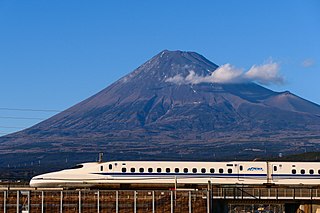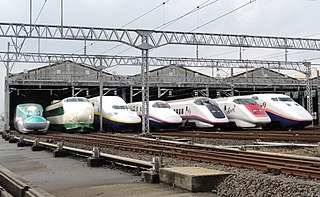Related Research Articles

High-speed rail (HSR) is a type of rail transport network utilizing trains that run significantly faster than those of traditional rail, using an integrated system of specialized rolling stock and dedicated tracks. While there is no single standard that applies worldwide, lines built to handle speeds above 250 km/h (155 mph) or upgraded lines in excess of 200 km/h (125 mph) are widely considered to be high-speed.

Ulaanbaatar, previously anglicized as Ulan Bator, is the capital and most populous city of Mongolia. With a population of 1.6 million, it is the coldest capital city in the world by average yearly temperature. The municipality is located in north central Mongolia at an elevation of about 1,300 metres (4,300 ft) in a valley on the Tuul River. The city was founded in 1639 as a nomadic Buddhist monastic centre, changing location 28 times, and was permanently settled at its modern location in 1778.

The Shinkansen, colloquially known in English as the bullet train, is a network of high-speed railway lines in Japan. Initially, it was built to connect distant Japanese regions with Tokyo, the capital, to aid economic growth and development. Beyond long-distance travel, some sections around the largest metropolitan areas are used as a commuter rail network. It is owned by the Japan Railway Construction, Transport and Technology Agency and operated by five Japan Railways Group companies.

The Acela is Amtrak's flagship passenger train service along the Northeast Corridor (NEC) in the Northeastern United States between Washington, D.C., and Boston via 13 intermediate stops, including Baltimore, New York City and Philadelphia. Acela trains are the fastest in the Americas, reaching 150 miles per hour (240 km/h), but only over 49.9 miles (80.3 km) of the 457-mile (735 km) route.

Hohhot, formerly known as Kweisui, is the capital of Inner Mongolia in the north of the People's Republic of China, serving as the region's administrative, economic and cultural center. Its population was 3,446,100 inhabitants as of the 2020 census, of whom 2,944,889 lived in the metropolitan area consisting of 4 urban districts plus the Tümed Left Banner.

A railbus is a lightweight passenger railcar with an automotive engine. They shares many aspects of its construction with a bus, typically having a bus body and four wheels on a fixed base instead of on bogies. Originally designed and developed during the 1930s, railbuses have evolved into larger dimensions with characteristics similar in appearance to a light railcar, with the terms railcar and railbus often used interchangeably. Railbuses designed for use specifically on little-used railway lines were commonly employed in countries such as Germany, Italy, France, the United Kingdom, and Sweden.

Beijing, as the capital and one of the four municipalities of the People's Republic of China (PRC), is a transport hub, with a sophisticated network of roads, railways and two major airports. Five completed ring roads encircle the city with nine expressways heading in virtually all compass directions, supplemented by eleven China National Highways.

The Lincoln Service is a 284-mile (457 km) higher-speed rail service operated by Amtrak that runs between Chicago, Illinois and St. Louis, Missouri. The train is a part of the Illinois Service and is partially funded by the Illinois Department of Transportation. The train uses the same route as the long-distance Texas Eagle, which continues to San Antonio and Los Angeles. A connection with the Kansas City-bound Missouri River Runner is available in St. Louis.

The Chicago Hub Network is a collection of proposed fast conventional and high-speed rail lines in the Midwestern United States including 3,000 miles (5,000 km) of track. Since the 1990s, there have been multiple proposals to build a network from Chicago to destinations such as Milwaukee, Madison, Minneapolis, Indianapolis, Detroit, Kansas City, St. Louis, Cleveland, Cincinnati, and Louisville. In addition, the rail lines from the Chicago hub would connect through to cities in Canada. Eastern routes from Chicago would also blend into the Ohio Hub network. In addition to providing better connections between Midwestern cities, the projects are intended to reduce or eliminate the operating subsidies that American passenger train routes currently require.

The Southeast Corridor (SEC) is a proposed passenger rail transportation project in the Mid-Atlantic and Southeastern United States to extend high-speed passenger rail services from the current southern terminus of the Northeast Corridor in Washington, D.C.. Routes would extend south via Richmond and Petersburg, Virginia, with a spur to Norfolk in Virginia's Hampton Roads region; the mainline would continue south to Raleigh, Durham, Greensboro, and Charlotte, North Carolina. Since the corridor was first established in 1992, the U.S. Department of Transportation (USDOT) has extended it further to Atlanta, Georgia and Macon, Georgia; Greenville, South Carolina; Columbia, South Carolina; Jacksonville, Florida; and Birmingham, Alabama.

The Beijing–Shanghai high-speed railway is a high-speed railway that connects two major economic zones in the People's Republic of China: the Bohai Economic Rim and the Yangtze River Delta. Construction began on April 18, 2008, with the line opened to the public for commercial service on June 30, 2011. The 1,318-kilometer (819 mi) long high-speed line is the world's longest high-speed line ever constructed in a single phase.

Several plans have been proposed for high-speed rail in Canada, the only G7 country that does not have any high-speed rail. In the press and popular discussion, there have been two routes frequently proposed as suitable for a high-speed rail corridor: Edmonton to Calgary via Red Deer and Windsor to Quebec City via London, Kitchener-Waterloo, Toronto, Ottawa and Montreal.

The Wolverine is a higher-speed passenger train service operated by Amtrak as part of its Michigan Services. The 304-mile (489 km) line provides three daily round-trips between Chicago and Pontiac, Michigan, via Ann Arbor and Detroit. It carries a heritage train name descended from the New York Central.
The Northern Lights Express (NLX) is a planned higher-speed rail service that would run 155 miles (249 km) between Minneapolis and Duluth primarily in the U.S. state of Minnesota. A portion of the proposed line would run through neighboring Wisconsin to serve Duluth's "Twin Port" of Superior. Plans are to upgrade an existing BNSF Railway freight line to allow trains to travel at up to 90 miles per hour (145 km/h). The train service is said to provide an alternative to traveling Interstate 35 between Duluth and the Twin Cities or to other destinations along the line such as the casino in Hinckley.
The Stadler Regio-Shuttle RS1 is the first widely used, new-generation, diesel railcar in Germany and Czech Republic for local railway services. Its most characteristic feature is the trapezium-shaped window frames. The Regio-Shuttle is classified by the Deutsche Bahn as Class 650, by the České Dráhy as Class 840 or Class 841, however numerous private railways have their own Regio-Shuttles.

Indian Railways operates India's railway system and comes under the purview of the Ministry of Railways of Government of India. As of 2023, it maintains over 108,706 km (67,547 mi) of tracks and operates over 13,000 trains daily. According to the Ministry of Railways, a route capable of supporting trains operating at more than 160 km/h (100 mph) is considered as a higher speed or semi-high speed rail line.

The Fuzhou–Xiamen railway or Fuxia railway is a dual-track, electrified, higher-speed rail line in eastern China. The line is named after its two terminal cities Fuzhou and Xiamen, both coastal cities in Fujian. The line has a total length of 274.9 kilometres (170.8 mi) and forms part of China's Hangzhou–Fuzhou–Shenzhen passenger-dedicated railway. Construction began in 2005, and the line entered into operation on April 26, 2010.

Higher-speed rail (HrSR), also known as high-performance rail, higher-performance rail, semi-high-speed rail or almost-high-speed rail, is the jargon used to describe inter-city passenger rail services that have top speeds of more than conventional rail but are not high enough to be called high-speed rail services. The term is also used by planners to identify the incremental rail improvements to increase train speeds and reduce travel time as alternatives to larger efforts to create or expand the high-speed rail networks.

Ulaanbaatar Metro is a rapid transit system in the planning stages in Ulaanbaatar, Mongolia. The Ulaanbaatar Metro project was approved in 2012, and construction was originally planned to be completed by 2020, however, as of 2023 it is still not open. However, in December 2023, it has been announced that in June 2024, there would be an opening ceremony and the construction of the metro would be completed in 2027 and the metro will be put into operation in 2028.

Rail transport is an important mode of long-distance transportation in China. As of 2024, the country had more than 159,000 km (98,798 mi)[a] of railways, the second longest network in the world. By the end of 2023, China had more than 45,000 kilometres of high-speed rail (HSR), the longest HSR network in the world.
References
- 1 2 Uchral, G. (19 June 2014). "Railbus: A time saver for Ulaanbaatar". UB Post. Archived from the original on 26 July 2014. Retrieved 16 July 2014.
- ↑ "City Railbus in service from today". English News MN. 6 June 2014. Archived from the original on 22 July 2015. Retrieved 16 July 2014.